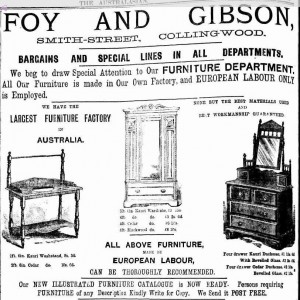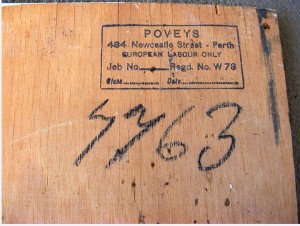Dresser With a Black 135 Stamp on the Back
European labour stamps on Australian furniture
- September 11, 2015 at 17:34
- in Social life & customs, Such was life

Look closely at some old furniture in your home or workplace and you may see the words 'European labour only' stamped on it. You may think you have a finely crafted piece of furniture made in Germany or France. But don't rush to the antique dealer too quickly. These stamps were common on furniture made in Australia before the 1960s.
The 'European labour only' stamp was a legal requirement in Victoria, and in most other states. In Victoria it was set out in the Factories and Shops Act of 1896. It was later incorporated in different Acts over time under various names, finally remaining in 1958 as part of the Labour and Industry Act. The purpose of the legislation was to distinguish between furniture made in Victoria by Chinese workers and that made by Europeans, meaning Australians of European origin.

The Australasian, 13 March, 1897, p. 4, advertisement
indicating 'European Labour' made furniture.
In the 1880s there was great concern about what was known as 'sweated labour' or 'sweating'. This was the use of labour in highly exploitative conditions. It usually meant workers subjected to very long hours, unsafe conditions, low pay and insecure employment. The Chinese community were often accused of making use of 'sweated labour', especially in the manufacture of furniture.
Unions accused the Chinese workers of unfairly undermining the conditions of European workers, while employers complained about unfair competition from Chinese owned businesses. Others said that the Chinese made furniture was of inferior quality. These views were contested by some at the time and later by historians such as Eric Rolls. Despite a lot of anti-Chinese sentiment it appears that many businesses were happy to sell Chinese made furniture, indeed some contemporary commentators felt it was 'absolutely impossible to commence the retail furniture business without selling Chinese made furniture'.

Illustration from the Australasian Sketcher,
Chinese Furniture Makers 1880, A/S24/04/80/69
After a series of Parliamentary inquiries such as the inquiry into the Factories and Shops Act 1890 and ongoing agitation from unions, employers and lobby groups, stamping legislation was introduced in 1896. Furniture had to be stamped as 'Chinese labour' or 'European labour only', or 'European and other labour' if a combination of labour sources was used. The stamping legislation, and other measures such as greater regulation of working hours did harm the viability of the Chinese furniture makers. Over a period of time their presence in the industry declined and eventually, virtually disappeared.
The problem of sweated labour was very real and attempts to reduce it were well-intentioned. But the Chinese and other non European communities did suffer from very prejudicial attitudes in this era. When Chinese workers were on strike against their employers for improved conditions in the 1880s and early 1890s they sought the support of the union movement but were rejected. There were even threats of using European labour against them as strike breakers.
Later attempts by the Chinese to be involved in the industry reform and regulation were also rejected. The rejection of the Chinese workers pleas for solidarity by their Australian or European fellow workers was a missed opportunity. What could have become a bridge between different communities remained a wall that divided them. A legacy of prejudice and misconceptions remained for generations. In Victoria the stamping regulations were in force until 1963. The last remaining references to European and Chinese Labour stamping was removed from the Labour and Industry Act 1958, by various new provisions in the Labour and Industry Amendment Act of 1963.

Wardrobe with European Labour Only stamp.
Image supplied courtesy of Karen Cheng's Fashion and Life blog,
Racist Furniture post, 18 April, 2011.
Further reading
Beaton, Lynn, Part of the furniture: Moments in the history of the Federated Furniture Trades Society of Victoria, Melbourne University Press: Carlton, Vic., 2007, pages 39-48.
Rolls, Eric, Citizens : Flowers and the wide sea: continuing the epic story of China's centuries-old relationship with Australia, University of Queensland Press: St. Lucia, Qld., 1996, pages 111-116.
About the Author
Dresser With a Black 135 Stamp on the Back
Source: https://blogs.slv.vic.gov.au/such-was-life/european-labour-stamps-on-australian-furniture/
0 Response to "Dresser With a Black 135 Stamp on the Back"
Post a Comment